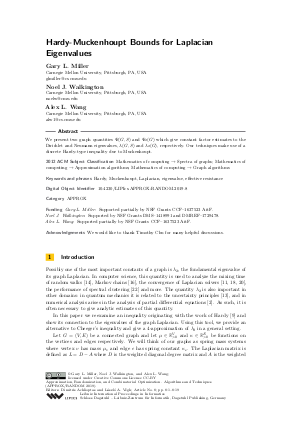Hardy-Muckenhoupt Bounds for Laplacian Eigenvalues
Authors Gary L. Miller, Noel J. Walkington, Alex L. Wang
-
Part of:
Volume:
Approximation, Randomization, and Combinatorial Optimization. Algorithms and Techniques (APPROX/RANDOM 2019)
Part of: Series: Leibniz International Proceedings in Informatics (LIPIcs)
Part of: Conference: International Conference on Randomization and Computation (RANDOM)
Part of: Conference: International Conference on Approximation Algorithms for Combinatorial Optimization Problems (APPROX) - License:
 Creative Commons Attribution 3.0 Unported license
Creative Commons Attribution 3.0 Unported license
- Publication Date: 2019-09-17
File

PDF
LIPIcs.APPROX-RANDOM.2019.8.pdf
- Filesize: 0.49 MB
- 19 pages
Document Identifiers
Subject Classification
ACM Subject Classification
- Mathematics of computing → Spectra of graphs
- Mathematics of computing → Approximation algorithms
- Mathematics of computing → Graph algorithms
Keywords
- Hardy
- Muckenhoupt
- Laplacian
- eigenvalue
- effective resistance
Metrics
- Access Statistics
-
Total Accesses (updated on a weekly basis)
0Document
0Metadata
Abstract
We present two graph quantities Psi(G,S) and Psi_2(G) which give constant factor estimates to the Dirichlet and Neumann eigenvalues, lambda(G,S) and lambda_2(G), respectively. Our techniques make use of a discrete Hardy-type inequality due to Muckenhoupt.
Cite As Get BibTex
Gary L. Miller, Noel J. Walkington, and Alex L. Wang. Hardy-Muckenhoupt Bounds for Laplacian Eigenvalues. In Approximation, Randomization, and Combinatorial Optimization. Algorithms and Techniques (APPROX/RANDOM 2019). Leibniz International Proceedings in Informatics (LIPIcs), Volume 145, pp. 8:1-8:19, Schloss Dagstuhl – Leibniz-Zentrum für Informatik (2019)
https://doi.org/10.4230/LIPIcs.APPROX-RANDOM.2019.8
BibTex
@InProceedings{miller_et_al:LIPIcs.APPROX-RANDOM.2019.8,
author = {Miller, Gary L. and Walkington, Noel J. and Wang, Alex L.},
title = {{Hardy-Muckenhoupt Bounds for Laplacian Eigenvalues}},
booktitle = {Approximation, Randomization, and Combinatorial Optimization. Algorithms and Techniques (APPROX/RANDOM 2019)},
pages = {8:1--8:19},
series = {Leibniz International Proceedings in Informatics (LIPIcs)},
ISBN = {978-3-95977-125-2},
ISSN = {1868-8969},
year = {2019},
volume = {145},
editor = {Achlioptas, Dimitris and V\'{e}gh, L\'{a}szl\'{o} A.},
publisher = {Schloss Dagstuhl -- Leibniz-Zentrum f{\"u}r Informatik},
address = {Dagstuhl, Germany},
URL = {https://drops.dagstuhl.de/entities/document/10.4230/LIPIcs.APPROX-RANDOM.2019.8},
URN = {urn:nbn:de:0030-drops-112236},
doi = {10.4230/LIPIcs.APPROX-RANDOM.2019.8},
annote = {Keywords: Hardy, Muckenhoupt, Laplacian, eigenvalue, effective resistance}
}
Author Details
Funding
- Miller, Gary L.: Supported partially by NSF Grants CCF - 1637523 AitF.
- Walkington, Noel J.: Supported by NSF Grants DMS - 1418991 and DMREF - 1729478.
- Wang, Alex L.: Supported partially by NSF Grants CCF - 1637523 AitF.
Acknowledgements
We would like to thank Timothy Chu for many helpful discussions.
References
-
Noga Alon and Vitali D Milman. λ₁, isoperimetric inequalities for graphs, and superconcentrators. Journal of Combinatorial Theory, Series B, 38(1):73-88, 1985.

-
Ivo Babuška and John E Osborn. Finite element-Galerkin approximation of the eigenvalues and eigenvectors of selfadjoint problems. Mathematics of computation, 52(186):275-297, 1989.

-
Thomas Bühler and Matthias Hein. Spectral clustering based on the graph p-Laplacian. In Proceedings of the 26th Annual International Conference on Machine Learning, pages 81-88. ACM, 2009.

-
Jeff Cheeger. A lower bound for the smallest eigenvalue of the Laplacian. In Proceedings of the Princeton conference in honor of Professor S. Bochner, 1969.

-
Jozef Dodziuk. Difference equations, isoperimetric inequality and transience of certain random walks. Transactions of the American Mathematical Society, 284(2):787-794, 1984.

-
Shayan Oveis Gharan. Lecture 12: Introduction to Spectral Graph Theory, Cheeger’s inequality. Lecture Notes, May 2016.

-
Stephen Guattery, F. Thomson Leighton, and Gary L. Miller. The Path Resistance Method For Bounding The Smallest Nontrivial Eigenvalue Of A Laplacian. Combinatorics, Probability & Computing, 8(5), 1999.

-
Stephen Guattery and Gary L. Miller. Graph Embedding and Laplacian Eigenvalues. SIAM J. Matrix Anal. Appl., 21(3):703-723, 2000.

- G.H. Hardy, Karreman Mathematics Research Collection, J.E. Littlewood, G. Pólya, D.E. Littlewood, and G. Pólya. Inequalities. Cambridge Mathematical Library. Cambridge University Press, 1952. URL: https://books.google.com/books?id=t1RCSP8YKt8C.
-
Nabil Kahale. A semidefinite bound for mixing rates of Markov chains. Random Structures & Algorithms, 11(4):299-313, 1997.

- Ioannis Koutis, Gary L. Miller, and Richard Peng. A Nearly-mlog n Time Solver for SDD Linear Systems. In Proceedings of the 2011 IEEE 52nd Annual Symposium on Foundations of Computer Science, FOCS '11, pages 590-598, Washington, DC, USA, 2011. IEEE Computer Society. Available at https://arxiv.org/abs/1102.4842. URL: https://doi.org/10.1109/FOCS.2011.85.
-
Alois Kufner, Lech Maligranda, and Lars-Erik Persson. The prehistory of the Hardy inequality. The American Mathematical Monthly, 113(8):715-732, 2006.

-
Gyu Eun Lee. Stability of matter. GSO Seminar, UCLA, 2017.

-
László Lovász et al. Random walks on graphs: A survey. Combinatorics, Paul erdos is eighty, 2(1):1-46, 1993.

-
Laurent Miclo. An example of application of discrete Hardy’s inequalities. Markov Process. Related Fields, 5(3):319-330, 1999.

- Bojan Mohar. Some applications of Laplace eigenvalues of graphs, pages 225-275. Springer Netherlands, Dordrecht, 1997. URL: https://doi.org/10.1007/978-94-015-8937-6_6.
-
Benjamin Muckenhoupt. Hardy’s inequality with weights. Studia Mathematica, 44(1):31-38, 1972.

- Y. Saad. Iterative Methods for Sparse Linear Systems. Society for Industrial and Applied Mathematics, Philadelphia, PA, USA, 2nd edition, 2003. Available at: URL: http://www-users.cs.umn.edu/~saad/toc.pdf.
- Aaron Schild. A Schur Complement Cheeger Inequality. arXiv preprint, 2018. URL: http://arxiv.org/abs/1811.10834.
- D. Spielman and S. Teng. Nearly Linear Time Algorithms for Preconditioning and Solving Symmetric, Diagonally Dominant Linear Systems. SIAM Journal on Matrix Analysis and Applications, 35(3):835-885, 2014. Available at http://arxiv.org/abs/cs/0607105. URL: https://doi.org/10.1137/090771430.
- Gilbert Strang. Linear algebra and its applications. Thomson, Brooks/Cole, Belmont, CA, 2006. URL: http://www.amazon.com/Linear-Algebra-Its-Applications-Edition/dp/0030105676.
-
Ulrike Von Luxburg. A tutorial on spectral clustering. Statistics and computing, 17(4):395-416, 2007.

